Vizio P75-E1, P55-E1, P65-E1 User Manual
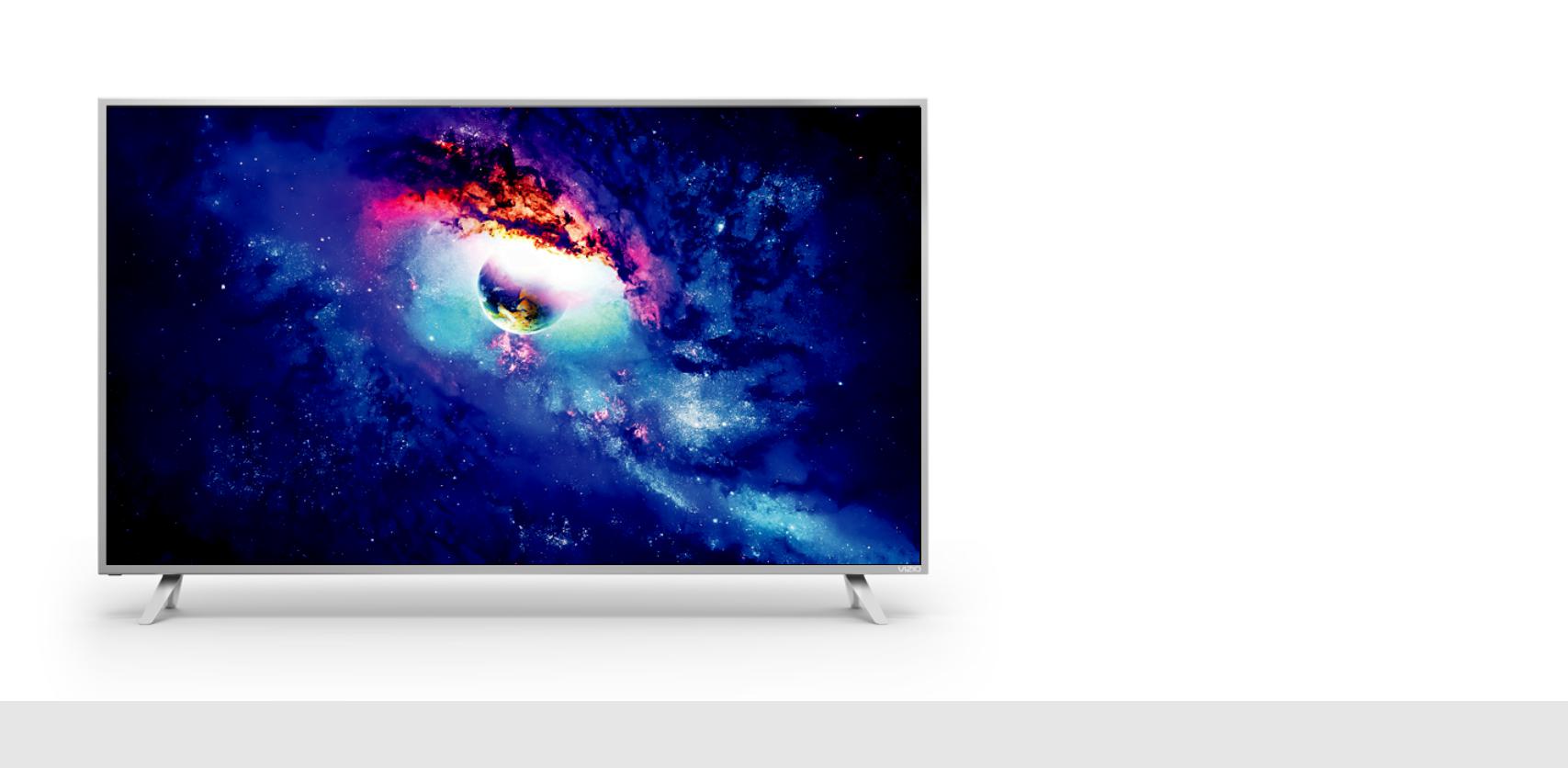
VIZIO
USER MANUAL
P55-E1, P65-E1, & P75-E1
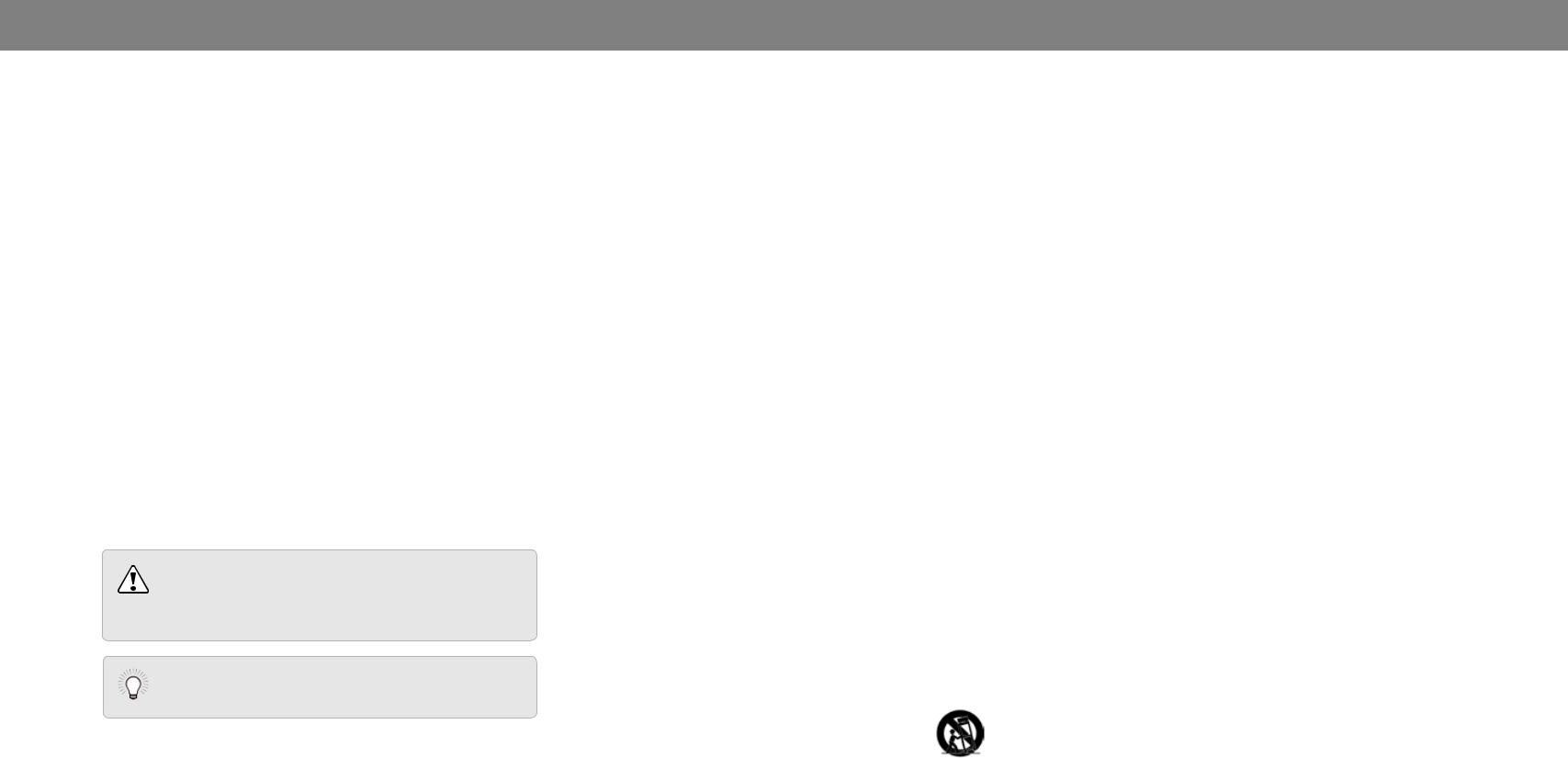
Safety & Certification
THANK YOU FOR CHOOSING VIZIO
And congratulations on your new VIZIO Display.
To get the most out of your new VIZIO product, read these instructions before using your product and retain them for future reference. Be sure to inspect the package contents to ensure there are no missing or damaged parts.
PRODUCT REGISTRATION
To purchase or inquire about accessories and installation services for your VIZIO product, visit our website at www.VIZIO.com or call toll free at (877) 698-4946.
We recommend that you register your VIZIO product at www.VIZIO.com
Extended Warranties
For peace of mind, and to protect your investment beyond the standard warranty, VIZIO offers on-site extended warranty service plans. These plans provide additional coverage during the standard warranty period.
To purchase an extended warranty service plan, visit www.VIZIO.com.
WHEN READING THIS MANUAL
When you see this symbol, please read the accompanying important warning or notice. It is intended to alert you to the presence of important operating instructions.
When you see this symbol, please read the accompanying helpful tip.
IMPORTANT SAFETY INSTRUCTIONS
Your Display is designed and manufactured to operate within defined design limits. Misuse may result in electric shock or fire. To prevent your Display from being damaged, the following instructions should be observed for the installation, use, and maintenance of your Display. Read the following safety instructions before operating your Display. Keep these instructions in a safe place for future reference.
•To reduce the risk of electric shock or component damage, switch off the power before connecting other components to your Display.
•Read these instructions.
•Keep these instructions.
•Heed all warnings.
•Follow all instructions.
•Do not use this apparatus near water.
•Clean only with dry cloth.
•Do not block any ventilation openings. Install in accordance with the manufacturer’s instructions.
•Do not install near any heat sources such as radiators, heat registers, stoves, or other apparatus (including amplifiers) that produce heat.
•Do not defeat the safety purpose of the polarized or grounding-type plug. A polarized plug has two blades with one wider than the other. A grounding type plug has two blades and a third grounding prong. The wide blade or the third prong are provided for your safety. If the provided plug does not fit into your outlet, consult an electrician for replacement of the obsolete outlet.
•Protect the power cord from being walked on or pinched particularly at plugs, convenience receptacles, and the point where they exit from the apparatus.
•Only use attachments/accessories specified by the manufacturer.
•Use only with the cart, stand, tripod, bracket, or table specified by the manufacturer, or sold with the apparatus. When a cart is used, use caution when moving the cart/apparatus combination to avoid injury from tip-over.
•Unplug this apparatus during lightning storms or when unused for long periods of time.
•Refer all servicing to qualified service personnel. Servicing is required when the apparatus has been damaged in any way, such as the power-supply cord or plug is damaged, liquid has been spilled or objects have fallen into the apparatus, the apparatus has been exposed to rain or moisture, does not operate normally, or has been dropped.
•Unplug the power cord before cleaning your Display.
•When moving your Display from an area of low temperature to an area of high temperature, condensation may form in the housing. Wait before turning on your Display to avoid causing fire, electric shock, or component damage.
•A distance of at least three feet should be maintained between your Display and any heat source, such as a radiator, heater, oven, amplifier etc. Do not install your Display close to smoke.
Operating your Display close to smoke or moisture may cause fire or electric shock.
•Slots and openings in the back and bottom of the cabinet are provided for ventilation. To ensure reliable operation of your Display and to protect it from overheating, be sure
these openings are not blocked or covered. Do not place your Display in a bookcase or cabinet unless proper ventilation is provided.
•Never push any object into the slots and openings on your Display cabinet. Do not place any objects on the top of your
Display. Doing so could short circuit parts causing a fire or electric shock. Never spill liquids on your Display.
•Your Display should be operated only from the type of power source indicated on the label. If you are not sure of the type of power supplied to your home, consult your dealer or local power company.
•Do not apply pressure or throw objects at your Display. This may compromise the integrity of the display. The manufacturer’s warranty does not cover user abuse or improper installations.
•The power cord must be replaced when using different voltage than the voltage specified. For more information, contact your dealer.
ii

•When connected to a power outlet, power is always flowing into your Display. To totally disconnect power, unplug the power cord.
•The lightning flash with arrowhead symbol within an equilateral triangle is intended to alert the user to the presence of un-isolated, dangerous voltage within the inside of your Display that may be of sufficient magnitude to constitute a risk of electric shock to persons.
•Do not overload power strips and extension cords. Overloading can result in fire or electric shock.
•The wall socket should be installed near your Display and easily accessible.
•Only power of the marked voltage can be used for your
Display. Any other voltage than the specified voltage may cause fire or electric shock.
•Do not touch the power cord during lightning. To avoid electric shock, avoid handling the power cord during electrical storms.
•Unplug your Display during a lightning storm or when it will not be used for long period of time. This will protect your Display from damage due to power surges.
•Do not attempt to repair or service your Display yourself.
Opening or removing the back cover may expose you to high voltages, electric shock, and other hazards. If repair is required, contact your dealer and refer all servicing to qualified service personnel.
•WARNING: Keep your Display away from moisture. Do not expose your Display to rain or moisture. If water penetrates into your Display, unplug the power cord and contact your dealer.
Continuous use in this case may result in fire or electric shock.
•Do not use your Display if any abnormality occurs. If any smoke or odor becomes apparent, unplug the power cord and contact your dealer immediately. Do not try to repair your Display yourself.
•Avoid using dropped or damaged appliances. If your Display is dropped and the housing is damaged, the internal components may function abnormally. Unplug the power cord immediately and contact your dealer for repair. Continued use of your Display may cause fire or electric shock.
•Do not install your Display in an area with heavy dust or high
humidity. Operating your Display in environments with heavy dust or high humidity may cause fire or electric shock.
•Follow instructions for moving your Display. Ensure that the power cord and any other cables are unplugged before moving your Display.
•When unplugging your Display, hold the AC/DC power adapter, not the cord. Pulling on the power cord may damage the wires inside the cord and cause fire or electric shock. When your Display will not be used for an extended period of time, unplug the power cord.
•To reduce risk of electric shock, do not touch the connector with wet hands.
•Insert batteries in accordance with instructions. Incorrect polarities may cause the batteries to leak which can damage the remote control or injure the operator. Do not expose batteries to excessive heat such as sunshine, fire or the like.
•If any of the following occurs, contact the dealer:
-The power cord fails or frays.
-Liquid sprays or any object drops into your Display.
-Your Display is exposed to rain or other moisture.
-Your Display is dropped or damaged in any way.
-The performance of your Display changes substantially.
•This apparatus shall not be exposed to dripping or splashing and no objects filled with liquids, such as vases, shall be placed on the apparatus.
•The mains plug or appliance coupler is used as the disconnect device, the disconnect device shall remain readily operable.
•CAUTION - These servicing instructions are for use by qualified service personnel only. To reduce the risk of electric shock, do not perform any servicing other than that contained in the operating instructions unless you are qualified to do so.
•The lightning flash with arrowhead symbol within an equilateral triangle is intended to alert the user to the H presence of uninsulated DANGEROUS VOLTAGE within
the product’s enclosure that may be of sufficient magnitude to constitute a risk of electrical shock to persons.
•WARNING: Exposure to loud sounds can damage your hearing causing hearing loss and tinnitus (ringing or buzzing in the ears). with continued exposure to loud noises, ears may
become accustomed to the sound level, which may result in permanent damage to hearing without any noticeable discomfort.
•Install the Display where it cannot be pulled, pushed or knocked over.
•Do not allow children to hang onto the product.
•Store the accessories (remote, batteries, etc.) in a location safely out of the reach of children.
•The American Academy of Pediatrics discourages television viewing for children younger than two years of age.
•WARNING: Never place a television set in an unstable I location. A television set may fall, causing serious
personal injury or death. Many injuries, particularly to children, can be avoided by taking simple precautions such as:
•Using cabinets or stands recommended by the manufacturer of the television set.
•Only using furniture that can safely support the television set
•Ensuring the television set is not overhanging the edge of the supporting furniture.
•Not placing the television set on tall furniture (for example, cupboards or bookcases) without anchoring both the furniture and the television set to a suitable support.
•Not placing the television set on cloth or other materials that may be located between the television set and the supporting furniture.
•Educating children about the dangers of climbing on furniture to reach the television set or its controls.
•If your existing television set is being retained and relocated, the same considerations as above should be applied.
iii

For DTS patents, see http://patents.dts.com.
Manufactured under license from DTS Licensing Limited. DTS, the Symbol, & DTS and the Symbol together are registered trademarks, and DTS Studio Sound II is a trademark of DTS, Inc. © DTS, Inc. All Rights Reserved.
Manufactured under license from Dolby Laboratories. Dolby, Dolby Audio, and the double-D symbol are registered trademarks of Dolby Laboratories.
HDMI, the HDMI logo and High-Definition Multimedia
Interface are trademarks or registered trademarks of HDMI Licensing LLC.
iv

Table Of Contents
Getting to Know Your Display...................................... |
6 |
Installing the Display on a wall........................................................... |
7 |
Rear Panel............................................................................................ |
8 |
Completing The First-Time Setup................................ |
10 |
Using the On-Screen Menu.......................................... |
11 |
Navigating the On-Screen Menu........................................................ |
11 |
Changing the Input Source................................................................. |
11 |
Changing the Screen Aspect Ratio..................................................... |
12 |
Adjusting the Picture Settings............................................................ |
13 |
Adjusting More Picture Settings...................................................... |
14 |
Adjusting the Color Temperature................................................... |
14 |
Adjusting the Picture Mode Edit Settings....................................... |
15 |
Saving a Custom Picture Mode....................................................... |
15 |
Locking/Unlocking a Custom Picture Mode................................... |
15 |
Deleting a Custom Picture Mode.................................................... |
16 |
Resetting a Picture Mode................................................................. |
16 |
Adjusting the Color Tuner Settings................................................. |
17 |
Adjusting the Audio Settings.............................................................. |
20 |
Changing the Equalizer Settings..................................................... |
20 |
Using the Network Connection Menu................................................ |
21 |
Connecting to a Wireless Network.................................................. |
21 |
Changing the Manual Setup Settings.............................................. |
21 |
Finding MAC Addresses for Network Setup................................... |
21 |
Connecting to a Hidden Network.................................................... |
22 |
Testing Your Network Connection.................................................. |
22 |
Setting Timers...................................................................................... |
23 |
Setting the Sleep Timer.................................................................... |
23 |
Setting the Auto Power Off Feature................................................ |
23 |
Renaming Devices on the Input Menu............................................... |
24 |
Changing the Display Settings............................................................ |
25 |
Checking for System Updates......................................................... |
25 |
Viewing System Information........................................................... |
25 |
Setting the Time and Local Settings................................................ |
25 |
Changing the On-Screen Menu Language...................................... |
26 |
Adjusting the CEC Settings.............................................................. |
26 |
Adjusting the Power Mode.............................................................. |
26 |
Turning the Power Indicator On or Off........................................... |
27 |
Changing the Display Name............................................................ |
27 |
Managing Mobile Devices................................................................ |
27 |
Using the Reset & Admin Menu......................................................... |
28 |
Restoring the Display to Factory Default Settings......................... |
28 |
About Viewing Data.......................................................................... |
28 |
Using the Info Window........................................................................ |
29 |
Playing USB Media........................................................ |
30 |
Preparing Your USB Drive to Play USB Media................................ |
30 |
Displaying USB Media...................................................................... |
30 |
Removing the USB Drive from the Display..................................... |
30 |
Troubleshooting & Technical Support........................ |
31 |
Specifications................................................................ |
35 |
Regulatory Information................................................ |
38 |
Limited Warranty.......................................................... |
39 |
Mexico Limited Warranty............................................. |
41 |
Legal Information......................................................... |
43 |
v
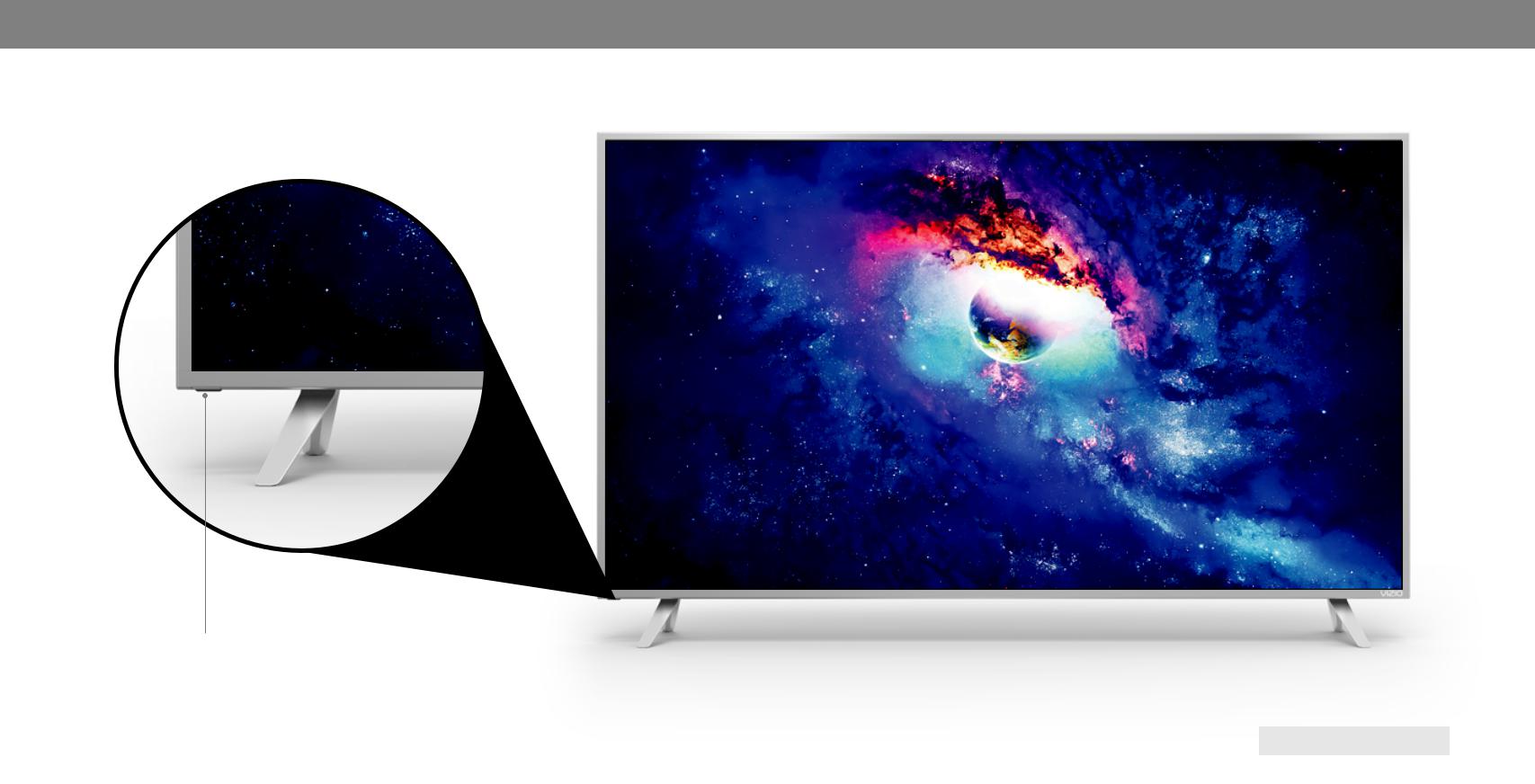
Getting to Know Your Display
REMOTE SENSOR & POWER INDICATOR
When using the remote, aim it directly at this sensor.
The power indicator flashes on when the Display turns on, then goes out after several seconds.
To keep the power indicator on as long as the Display is on, see Turning the Power Indicator On or Off on page 27.
FRONT PANEL
6
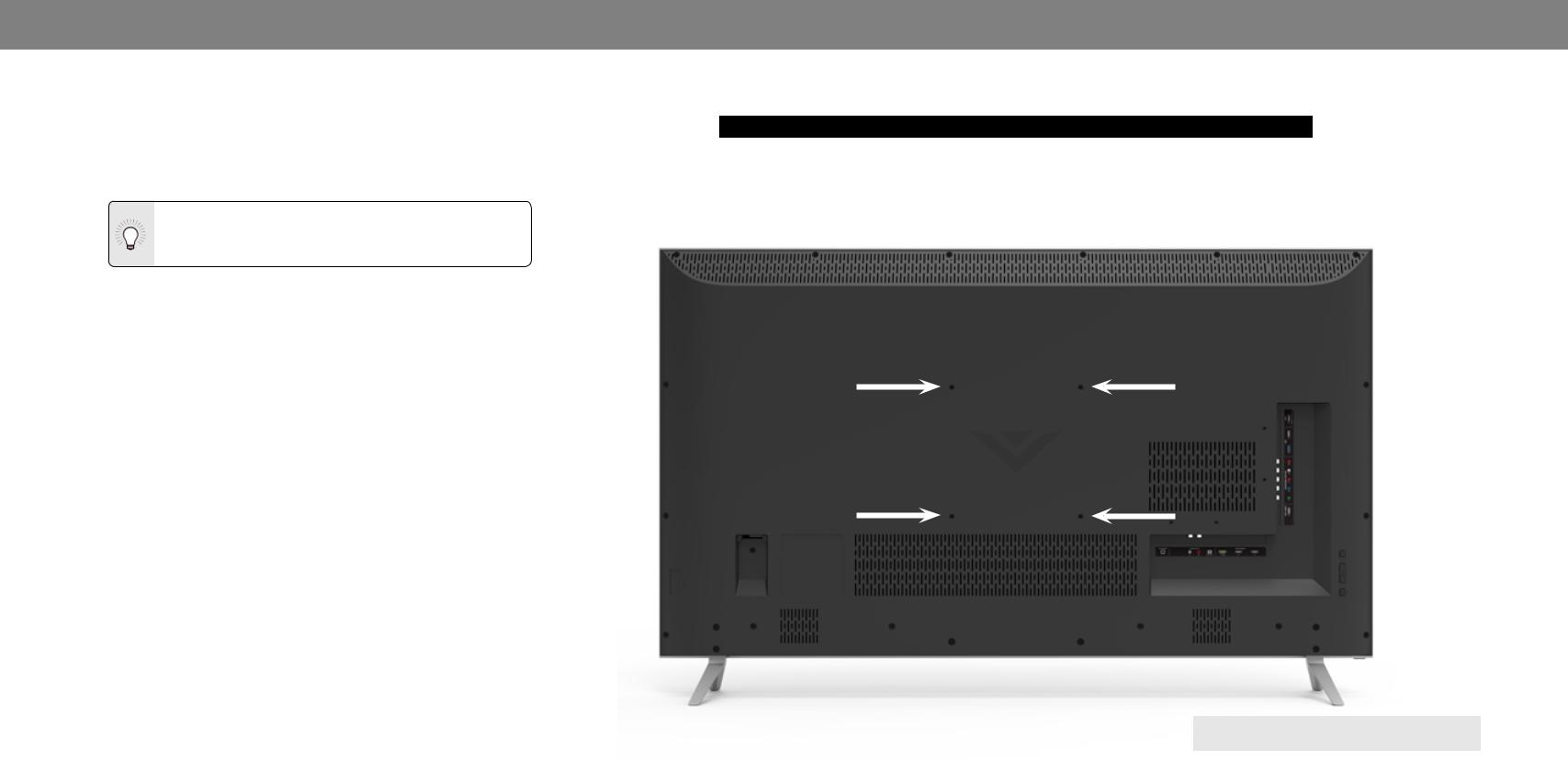
INSTALLING THE DISPLAY ON A WALL
To mount your display on a wall, you will need a wall mount.
Consult the information on this page to find the appropriate mount for your display model.
InstallingaDisplayonawallrequireslifting.Toprevent injury or damage to the Display, ask someone to help you.
Be sure the mount you choose is capable of supporting the weight of the display. After you have determined that you have the correct mount for your display, you can begin the installation.
To install your display on a wall:
1.Disconnect any cables connected to your display.
2.Place the display face-down on a clean, flat, stable surface. Be sure the surface is clear of debris that can scratch or damage the display.
3.Remove the stands by loosening and removing the screws.
4.Attach your display and wall mount to the wall, carefully following the instructions that came with your mount. Use only with a UL-listed wall mount bracket rated for the weight/ load of this display.
1
|
P55-E1 |
P65-E1 |
P75-E1 |
Screw Size: |
M6 |
M6 |
M8 |
Hole Pattern: |
300mm x 300 mm |
400mm x 400 mm |
400mm x 400 mm |
Weight w/o Stands: |
40.12 lb |
61.40 lbs |
103.62 lb |
WALL MOUNT SCREW LOCATIONS
Note: The image shown here is for illustrative purposes only and may be subject to change. The actual number of ports and their locations may vary, depending on the model.
7
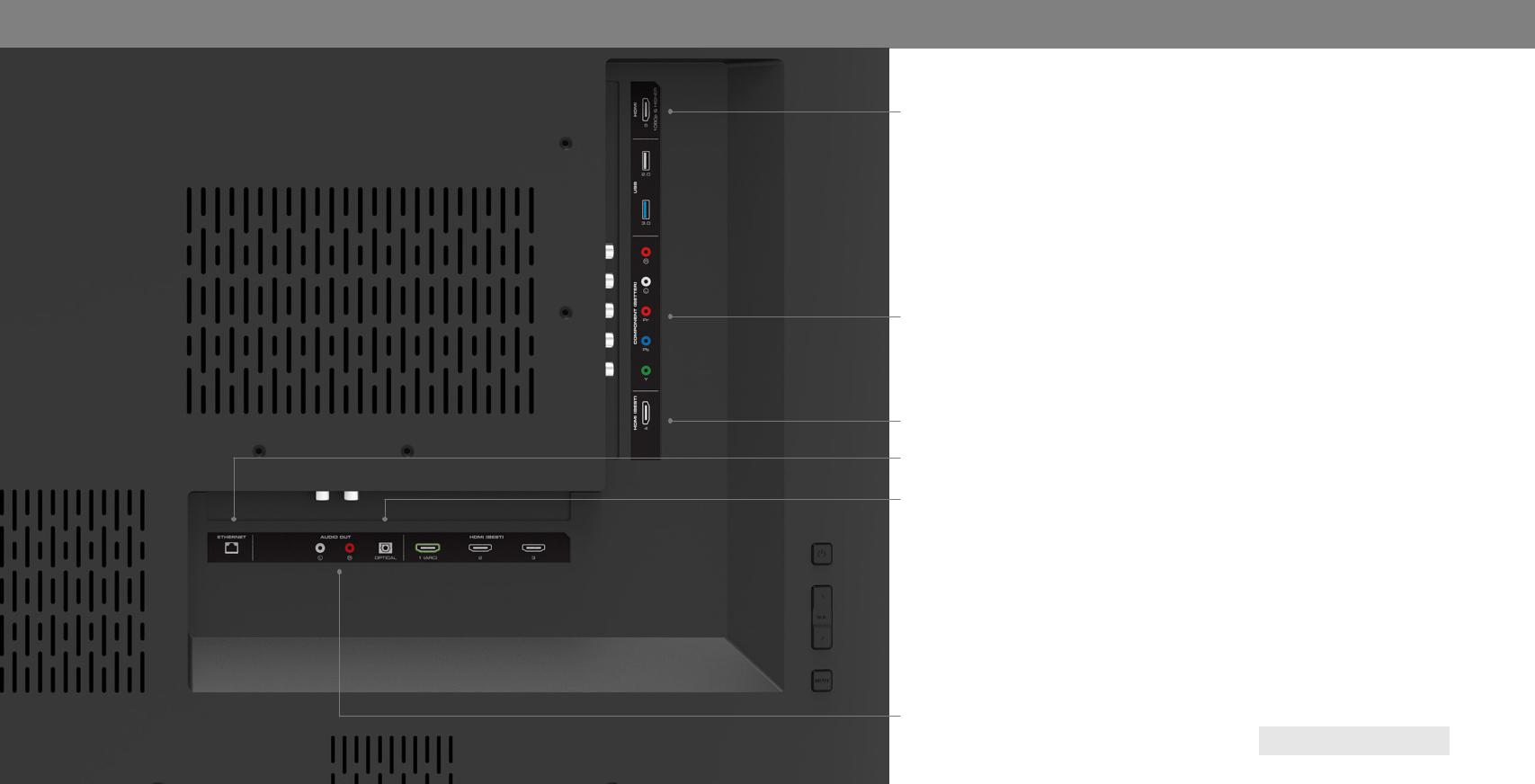
Note: The image shown here is for illustrative purposes only and may be subject to change. The actual number of ports and their locations may vary, depending on the model.
1
HDMI - Connect an HDMI device.
 USB - Connect a USB thumb drive to view videos
USB - Connect a USB thumb drive to view videos
Component - Connect a component device.
HDMI - Connect an HDMI device.
Ethernet - Connect an Ethernet cable to modem/ router.
Optical Audio Out - Connect an optical/SPDIF audio device, such as home audio receiver.
 Power - Press to turn the Display on or off.
Power - Press to turn the Display on or off.
 Volume - Press to adjust the Display volume.
Volume - Press to adjust the Display volume.
 Input - Press once to access the input menu.
Input - Press once to access the input menu.
Stereo Audio Out- Connect an RCA audio device, such as sound bar.
REAR PANEL
8
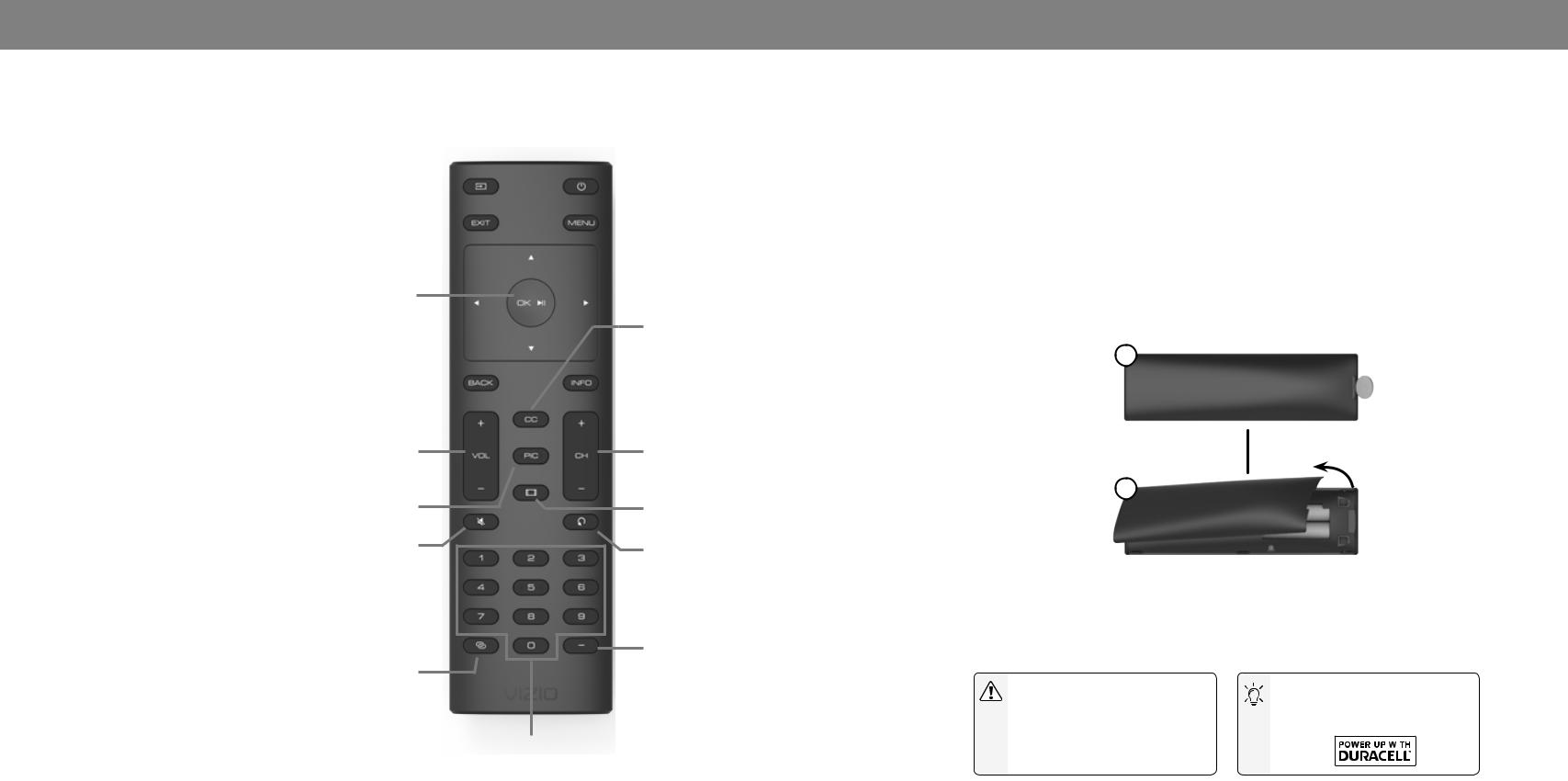
USING THE REMOTE
Input |
|
|
|
|
|
Power |
Change the currently displayed input. |
|
|
|
|
|
Turn Display on or off. |
Exit |
|
|
|
|
|
Menu |
Close the on-screen menu. |
|
|
|
|
|
Display the on-screen menu. |
OK/Play/Pause
Select the highlighted menu option and play or pause content.
Arrow
 Navigate the on-screen menu.
Navigate the on-screen menu.
Closed Caption
NOT SUPPORTED ON THIS MODEL.
Back |
|
|
|
Info |
Go to the previous on-screen menu. |
|
|
|
|
|
|
|
Display the info window. |
|
|
|
|
|
Volume Up / Down
Increase or decrease the loudness of the audio.
Pic
Cycle through the different picture setting modes.
Mute
Turn the audio on or off.
Setup/ Link
Activate pairing mode on the Display.
Channel Up / Down
NOT SUPPORTED ON THIS MODEL.
Wide
Cycle through the different aspect ratio modes.
Last
NOT SUPPORTED ON THIS MODEL
Dash
NOT SUPPORTED ON THIS MODEL.
Number Pad
NOT SUPPORTED ON THIS MODEL.
1
Inserting and replacing batteries.
Two AAA alkaline batteries are included for you to use with the basic remote control.
To insert/replace the batteries:
1.Find the notch on the back of the remote. Insert a coin and pry open the back cover.
2.Remove the back cover and insert two AAA batteries (included). Be sure to align the + and - signs on the batteries and remote.
1
2
VIZIO supports the proper handling and disposal of batteries. Please visit https://www.duracell.com/en-us/technology/battery-care-use-and-disposa/ for more information.
WARNING: |
When needed, VIZIO recommends |
|
Keep the remote control batteries away |
replacing the batteries that came with |
|
from children. It may cause choking |
this remote with two, new Duracell AAA |
|
and/or lead to a fire or chemical burn if |
alkaline batteries. |
|
mishandled. Do not dispose of batteries |
|
|
in fire. Replace only with batteries of the |
|
|
|
|
|
correct type. |
9 |
|
|
||
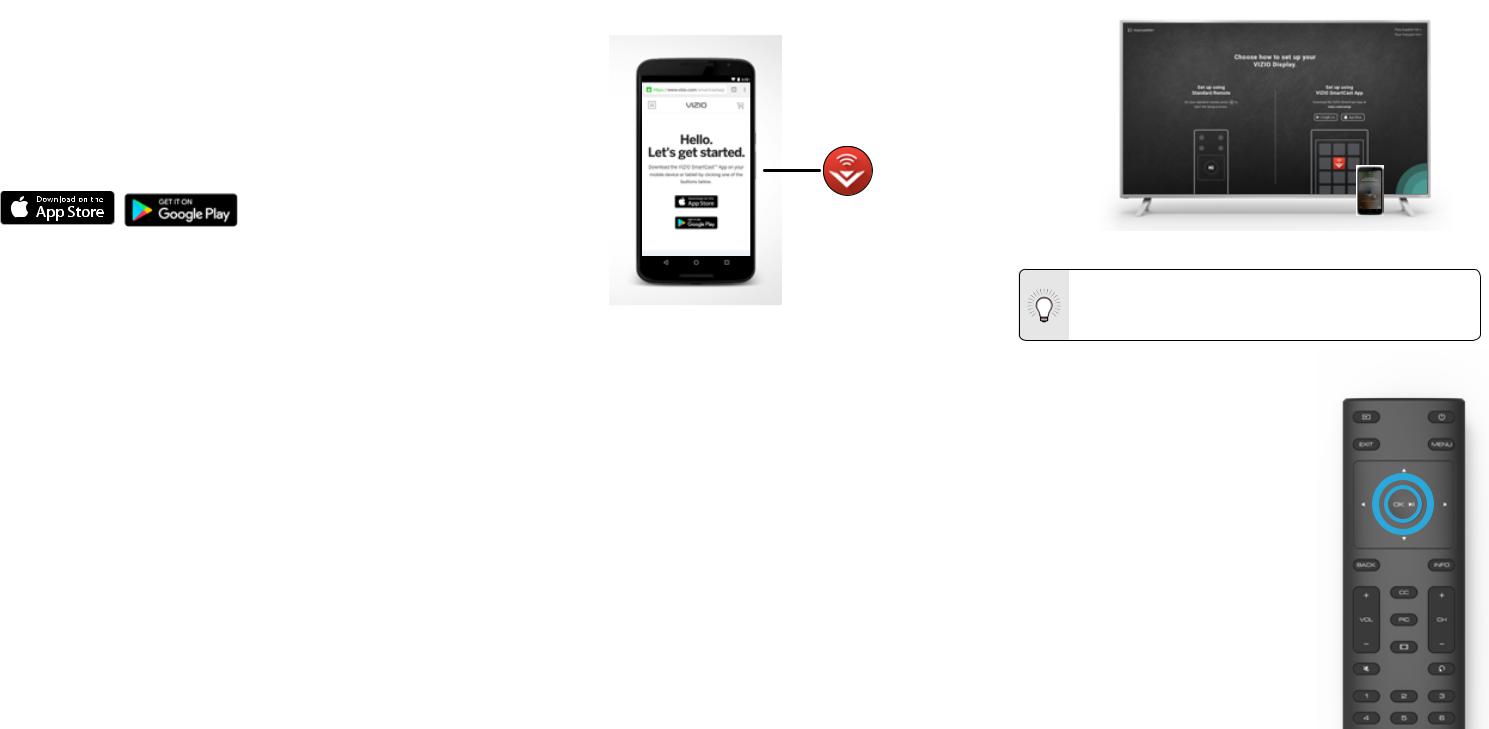
Completing The First-Time Setup |
2 |
The first time you turn on the Display, you can choose between two setup methods.
Complete Setup with the VIZIO SmartCast™ App (recommended):
Download the free VIZIO SmartCast™ App on your smartphone or tablet to set up your VIZIO display.
Use your phone to power on your display, adjust the volume, switch inputs, play and control streaming content from your iOS or Android device.
Go to http://www.vizio.com/setup to get started.
-OR-
Complete Setup with the IR Remote:
Use the included IR remote to manually set up your display.
The VIZIO SmartCast™ App is still VIZIO’s recommended setup method. Please note that a mobile device (not included) is still required to cast content from apps like Netflix and YouTube
Before you begin the first-time setup:
•Your Display should be installed and the power cord should be connected to an electrical outlet.
•Your devices should be connected.
•Ifyouhaveawirelessnetwork,havethenetworkpassword ready.
•If you are connecting to your network with an Ethernet cable, connect it to the Ethernet port on the Display.
Setup with the VIZIO SmartCast™ App
1.Download the free VIZIO SmartCast™ App on to your mobile device and launch the app
2.Pair your mobile device to your display. iOS Device Paring:
a.Select Get Started
b.Hold your mobile device next to the VIZIO logo on your Display.
Android Device Pairing:
Note the Wi-Fi setup name on the top corner of your Display.
a.Select Get Started and Select your preferred language
b.Select your Display name from the list shown on your device
3.Follow the instructions your mobile device and display screen to complete setup.
Need help installing the display?
Refer to the printed Quick Start Guide for detailed instructions on how to install your new P-Series display. You can also find a digital copy on support.vizio.com
Setup with the IR Remote
1.Press the OK/Play key on your IR remote during the initial setup screen.
2.Use the Arrow Keys and the OK/Play button to select and confirm settings.
3.Follow the instruction on the screen to complete setup.
10

Using the On-Screen Menu |
3 |
Your Display features an easy-to-use on-screen menu.
To open the on-screen menu, press the MENU button on the remote.
From this menu, you can:
•Adjust the Picture settings
•Adjust the Audio settings
•Adjust Network Settings
•Setting the Sleep Timers
•Name Inputs
•Adjust Display settings
•Access the user manual
Display Settings
Picture
Audio
Network
Timers
Inputs
System
Closed Captions
User Manual
NAVIGATING THE ON-SCREEN MENU
To open the on-screen menu, press the MENU button on the remote.
Use the Arrow buttons to highlight a menu option, and press the OK button to select that option.
While navigating the on-screen menu, you can press the BACK button at any time to return to the previous menu screen. The EXIT button will close the on-screen menu.
CHANGING THE INPUT SOURCE
External devices such as DVD players, Blu-ray Players, and video game consoles can be connected to your Display. To use one of these devices with your Display, you must first change the input source using the Input menu.
To change the input source:
1.Press the INPUT button on the remote. The Input menu is displayed.
2.Use the Left/Right Arrow buttons or the INPUT button on the remote to highlight the input you wish to view and press OK. The selected input is displayed.
Input Name
Change Input
CAST |
HDMI-1 |
HDMI-2 |
HDMI-3 |
HDMI-4 |
COMP |
|
|
|
|
|
|
Note: Inputs may vary by Display.
You can change the input names that appear on the Input menu to make your devices easy to recognize. See Renaming Devices on the Input Menu for more information.
11

CHANGING THE SCREEN ASPECT RATIO
The Display can display images in five different modes: Normal,
Stretch, Panoramic, Wide, and Zoom. Each mode displays the picture differently.
Some programs have black bars on the top or sides of the picture so that the picture keeps its original shape. Examples include wide-screen movies and older television programs.
To change the screen aspect ratio:
1.Press the  WIDE button on the remote.
WIDE button on the remote.
2.Use the Arrow buttons to highlight the aspect ratio you wish to view and press OK.
•Normal preserves the content’s original aspect ratio and size.
•Standard Definition (480i and 480p—old Display programs) - Since the 4:3 aspect ratio is not large enough to fill the Display’s screen, black bars are added to the left and right of the display image.
•720p - Fills a 720p or 1080p screen.
•1080p and 1080i HD - Fills a 720p or 1080p screen.
•Stretch expands a widescreen image to fill the screen from top to bottom and stretches it half as much from right to left. Figures appear tall and thin.
•Standard Definition - Not available.
•720p - If you are watching widescreen 1.85:1 content, the image will fill the screen. With 2.35:1 widescreen content, one-sixth of the image is cut off by the left and right sides of the screen.
•1080p and 1080i - Not available.
•Panoramic stretches a 4:3 aspect ratio picture to the left and right edges of the screen. The center of the image is not stretched, but the sides of the image are extremely stretched. If you are watching widescreen (1.85:1 or 2.35:1) content with black bars on the top and bottom, the black bars will still appear on the top and bottom of the display
image.
•Standard Definition (480i and 480p) - Fills the screen from the left to right edges.
•720p - Not available.
•1080p and 1080i - Not available.
•Wide stretches a 4:3 aspect ratio picture to the edges of the screen. Since the picture is being stretched, the display image may appear distorted—figures appear short and fat.
If the program is already formatted for widescreen viewing (1.85:1 or 2.35:1), then black bars will appear on the top and bottom of the display image.
• Zoom expands images evenly in all directions (33% taller |
Normal Panoramic |
Wide |
Zoom |
|
|
|
|
and 33% wider) with black bars to fit the screen. A 720p |
|
|
|
image will fill a 1080p screen. |
|
|
|
• Standard Definition - Not available. |
|
|
|
• 720p - Fills a 720p screen |
|
|
|
• 1080p and 1080i - Not available. |
|
|
|
Note: Aspect ratio settings may vary by Input source.
Tip: The aspect ratio cannot be changed for Ultra HD, HDR content or for any video content on HDMI-4.
12

ADJUSTING THE PICTURE SETTINGS
Your Display can be adjusted to suit your preferences and viewing conditions.
If you’ve changes to the settings for a picture mode, an asterisks appears after its name (see Saving a Custom Picture Mode).
To adjust the picture settings:
1.Press the MENU button on the remote. The on-screen menu is displayed.
2.Use the Arrow buttons on the remote to highlight Picture and press OK. The PICTURE menu is displayed.
3.Use the Arrow buttons on the remote to highlight Picture Mode, then use the Left/Right Arrow buttons to change the picture mode:
•Standard mode sets the picture settings to the default settings.
•Calibrated mode sets the picture settings to values ideal for watching Display in a brightly-lit room.
•Calibrated Dark mode sets the picture settings to values ideal for watching Display in a dark room.
•Vivid mode sets the picture settings to values that produce a brighter, more vivid picture.
Picture |
|
|
|
|
Back |
|||
|
|
|
|
|||||
|
|
|
|
|
||||
Picture Mode |
Calibrated |
|||||||
Auto Brightness Control |
|
|
|
|
Off |
|||
Backlight |
|
|
|
|
|
90 |
||
|
|
|
|
|
||||
Brightness |
|
|
|
|
50 |
|||
|
|
|
|
|||||
Contrast |
|
|
|
50 |
||||
|
|
|
|
|||||
Color |
|
|
|
50 |
||||
|
|
|
|
|||||
Tint |
|
|
|
0 |
||||
|
|
|
|
|||||
Sharpness |
|
|
|
20 |
||||
|
|
|
||||||
More Picture |
|
|
|
|
|
|||
Picture Mode Edit |
|
|
|
|
|
|||
Color Calibration |
|
|
|
|
|
|||
|
|
|
|
|
|
|
|
|
•Game mode reduces throughput delays and optimizes the picture settings for displaying game console output.
•Computer mode optimizes the picture settings for displaying computer output.
4.To manually change each of the picture settings, use the Up/ Down Arrow buttons on the remote to highlight that picture setting, then use the Left/Right Arrow buttons to adjust the setting:
•Auto Brightness Control - The auto brightness control detects the light levels in the room and automatically adjusts the backlight for the best picture. Select Off, Low, Medium, or
High.
•Backlight - Adjusts the LED brightness to affect the overall brilliance of the picture. Backlight cannot be adjusted when starting from some picture modes.
•Brightness - Adjusts the black level of the picture. When this setting is too low, the picture may be too dark to distinguish details. When this setting is too high, the picture may appear faded or washed out.
•Contrast - Adjusts the white level of the picture. When this setting is too low, the picture may appear dark. When this setting is too high, the picture may appear faded or washed out. If the setting is too high or too low, detail may be difficult to distinguish in dark or bright areas of the picture.
•Color - Adjusts the intensity of the picture colors.
•Tint - Adjusts the hue of the picture. This setting is useful in adjusting the flesh tones in the picture. If flesh appears too orange, reduce the level of color before adjusting tint.
•Sharpness - Adjusts the edge sharpness of picture elements.
It can be used to sharpen non-HD (high definition) content; however, it will not produce detail that does not otherwise exist.
5.When you have finished adjusting the picture settings, press the EXIT button on the remote.
13

Adjusting More Picture Settings
To adjust more picture settings:
1. From the PICTURE menu, use the |
More Picture |
|
|
Back |
|
|
|
||||
Arrow buttons to highlight More |
|
|
|
||
Picture, and then press OK. |
Color Temperature |
Normal |
|||
2. Use the Arrow buttons to |
Black Detail |
|
|
Off |
|
Active LED Zones |
|
|
On |
||
highlight the setting you wish |
|
|
|||
|
|
|
|
||
to adjust, then press the Left/ |
Motion Control |
|
|
|
|
Right Arrow buttons to change |
Clear Action |
|
|
Off |
|
the setting: |
Reduce Noise |
|
|
|
|
• |
Color Temperature - |
Game Low Latency |
|
|
Off |
|
See Adjusting the Color |
Pure Cinema |
Auto |
||
|
Temperature on this page. |
Color Space |
Auto |
||
• |
Black Detail - Adjusts the |
Gamma |
2.1 |
||
|
average brightness of the |
|
|
|
|
|
picture to compensate for |
|
|
|
|
|
large areas of brightness. |
|
|
|
|
|
Select Off, Low, Medium, or |
|
|
|
|
|
High. |
|
|
|
|
•Active LED Zones - Dynamically improves the contrast ratio of the picture by adjusting the backlight. The adjustment is controlled by the content on the screen. Select On or Off.
•Motion Control - Opens a sub-menu with two settings:
•Reduce Juddar - Activates Smooth-Motion motion estimation/ motion compensation, which supresses motion juddar, or “studdering” of the image when the camera moves across a scene horizontally. As the setting increases, juddar is reduced.
•Reduce Motion Blur - Increase frame rate to reduce motion blur of 60hz video. As the setting increases, motion blur is reduced.
•Clear Action - Reduces blur in scenes with fast action.
Some sensitive viewers may notice flickering. Select On or
Off.
•Reduce Noise - Opens a sub-menu with two settings:
•Reduce Signal Noise - Diminishes artifacts in the image caused by the digitizing of image motion content. Select
Off, Low, Medium, or High.
•Reduce Block Noise - Reduces pixelation and distortion for mpeg files. Select Off, Low, Medium, or High.
•Game Low Latency - Select On to reduce video delay (lag) when gaming.
•Pure Cinema Mode - Optimizes the picture for watching film. Select Auto or Off.
•Color Space - Select Color Space for the source. Video sources uses YCbCr, but PC uses RGB.
•Gamma - Set the shape of the Gamma curve. Use lower Gamma values for bright room conditions, and higher values when it’s dark.
3.When you have finished adjusting More Picture Settings, press the
EXIT button on the remote.
Adjusting the Color Temperature
Adjusting the color temperature changes the white balance of the picture.
To adjust the color temperature:
1.From the MORE PICTURE menu, use the Arrow buttons to highlight Color Temperature, and then press OK.
2.Use the Arrow buttons on the remote to highlight a color temperature preset and then press OK.
•Normal is optimized for television viewing.
•Cool produces a blue-hued picture.
•Computer optimizes the picture for use as a
PC monitor.
Back
Color Temperature
Normal
Cool
Computer
3.When you have finished adjusting the color temperature, press the EXIT button on the remote.
14
